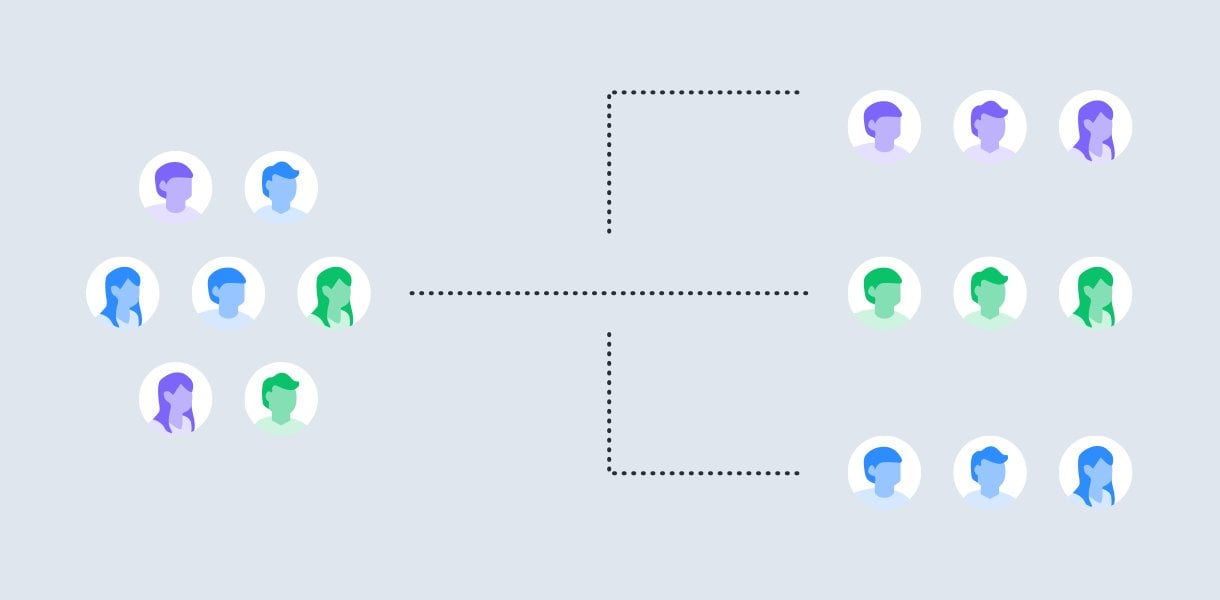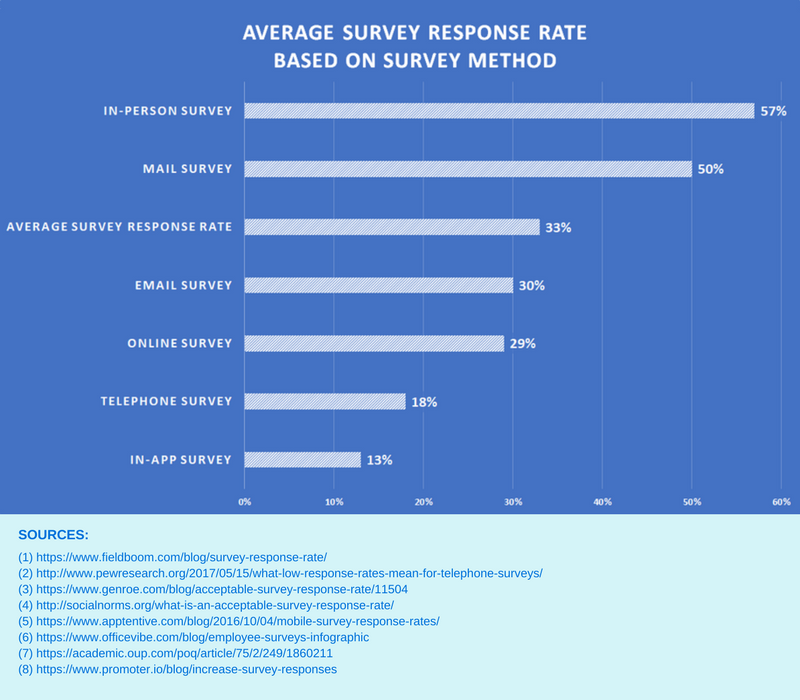Email surveys have an average survey response rate of 30%, and online surveys have a response rate of 29%. Below is a comprehensive report on some of the best practices employed to complete an email/online survey. Additionally, research has shown that incentives can increase your survey response rate by 10 to 15%. Insights on how incentives affect survey response rates are also provided in this report.
Table of Contents
BEST PRACTICES TO GET USERS TO COMPLETE ONLINE SURVEYS
1. Sender’s Email Address
- The first thing that the recipients of a survey see is the email address. Therefore, it is prudent to make sure that your recipients identify the email that is sending them the survey. From whom email addresses should be familiar to the recipients.
- According to Smart Survey, “43% of all recipients click the Spam button on emails where they don’t recognize the ‘from’ name or email address.”
- Additionally, 64% of survey participants are likely to open an email if they immediately recognize and trust the sender’s name.
- Therefore, a good practice is to avoid using personal email to send surveys and instead use the official company email that is easily identifiable. The reason being that recipients might be inclined not to open an email from a personal email address that they do not know and might even flag it as spam.
- Additionally, it is good practice to use the same email address you use for newsletters and communications for surveys. According to the survey monkey, having a whitelisted address is key to email correspondence.
2. Survey Length
- One of the principles that MailerLite identified as helpful in increasing the survey response rate is indicating the time it takes for a participant to complete a survey. Mailer Lite advises the owner of the survey to take the survey first and record the accurate time it takes to complete the survey. The participant should be told whether the survey is a long survey or a short survey based on accurate data in the invitation email.
- Therefore, it is good practice to tell your participants how long the survey will take and be careful not to exceed the time frame set.
- However, it is important to note that people get distracted very fast, and a survey should, therefore, include only relevant questions.
- According to Survey Anyplace, a survey with more than 12 questions or takes more than 5 minutes to complete experience a 15% drop in response rate. The drop in response rate increases as the time to take the survey increases. A survey that takes more than 10 minutes to complete shows a drop of up to 40% in response rate.
3. Target Audience
- Survey Anyplace identifies sending the same survey to different audiences as a common mistake done by companies.
- One should, therefore, target audiences in your email list that are likely to respond. Targeting the right audience will improve not only your response rate but also the quality of survey responses.

- Surveys aimed at a B2C audience will yield a response rate that is 12% lower than surveys aimed at B2B audiences. Additionally, surveys that target an internal audience have a 20% higher response rate than surveys aimed at an external survey.
- Creating various target groups for your survey will help in the following ways:
- Targeting different audiences will enable the survey to include very specific questions that will provide better survey data.
- Creating target groups will allow you to personalize your emails, which will, in turn, improve open and click rates.
- Additionally, targeting different groups will help avoid annoying people who are not involved with the survey with emails.
4. Survey email Invitation
- MailerLite identifies writing a clear and compelling survey invitation as a best practice if one wants to increase their survey response.
- The survey invitation email should let your recipients know how important their participation is to you. Below are a few principles to help write an email survey invitation:
- One needs to clarify the purpose of the survey in a super simple language. The invitation should have a singular goal for the survey.
- The invitation should also explain why the participants were chosen (are they V.I.P or a special group of people).
- The invitation should also show how the participants will benefit from taking the survey.
- Additionally, the invitation should let the participants know how long the survey will take. Readers should be aware of whether the survey will take a long time or a short time.
- Lastly, the invitation should thank the participants.
INSIGHTS ON EFFECT OF INCENTIVES ON SURVEY RESPONSE RATES
- Email surveys have an average survey response rate of 30%, and online surveys have a response rate of 29%.
- According to Survey AnyPlace, “studies have shown that having an incentive can increase your response by 10 to 15% depending on the quality and attractiveness of the incentive to your target audience.”
- Another study indicated that incentives could increase the survey response rate by 5% — 20%.
- However, a difference in the increase in the response rate between monetary and non-monetary incentives exist. The use of monetary rewards increases the survey response rate by 19.1%, while non-monetary rewards increase the survey response rate by 7.9%.
1. Intrinsic Rewards
- According to many research experts, useful/relevant information is one of the most effective forms of incentives to business audiences.
- Businesses deem useful/relevant information as information that will better help them improve certain aspects of their services or products. Businesses will be more inclined to respond to a survey if data from the survey will, in turn, help improve their customers’ experience.
- Therefore, a survey should inform their respondents that it is in their best interest to answer the survey.
2. Extrinsic Rewards
- Another way to increase the response rate of surveys is by offering respondents extrinsic rewards. Extrinsic rewards include coupons, discounts, and cash, among other deals.
- However, it is important to note that the downside of providing extrinsic rewards is that some respondents will only participate to get the reward and might therefore provide invalid or unusable responses. To avoid this, the survey must provide an incentive that, while extrinsic, is not of any extreme value.
3. Timing of Incentives
- Another crucial factor that determines the effectiveness of incentives is when the incentive is given.
- The incentive can be given before the respondents complete the survey (prepaid) or can be given after they have completed the survey (promised)
- Research shows that prepaid incentives are more effective in increasing the response rate than promised incentives.
- It is, however, more costly to provide prepaid incentives than promised incentives. Additionally, it is harder to execute prepaid incentives for online surveys.
4. Promised Incentives
- When providing promised incentives, it is better to offer individual incentives than sweepstakes incentives.
- Individual incentive rewards every participant of the survey, while sweepstakes incentive rewards one or a few of the survey participants. Sweepstakes incentives give participants a chance to win a reward after completing the survey.
- Even though both incentives increase response rates, it is important to note that individual incentives have higher response rates than sweepstakes incentives.
- In a study conducted by e-Rewards Market Research, individual incentives provided a response rate of 19.3%, while sweepstakes incentives provided a response rate of 12.2%. The study proved that “people prefer to complete a survey when they are certain they’ll receive something instead of the slim chance of winning a big prize.”
5. When to Use Incentives
- It is important to note that certain surveys may not need incentives because incentives will only harm the quality of feedback received. An example of such a survey is customer satisfaction surveys.
- One of the best scenarios that require the use of survey incentives is when targeting a rare population (for example, doctors) or a group of non-responders.
- It is effective to contact non-responders of an initial survey and offer them an incentive if they respond. This will help reduce bias in the response one gets.
ONLINE SURVEY TRENDS
1. Embedded Surveys
- Embedded surveys differ from traditional email surveys that provided participants with a link or a button that sent them to the survey. On the other hand, an embedded survey launches in the same browser allowing participants to complete all the survey questions in one seamless step.
- An embedded survey is more effective than traditional email surveys since it does not rely on a click-through before the participant gets to see the survey. It gives the participant the ability to start the survey directly from the newsletter.
- Research done by Mailer Lite showed that embedded surveys got 135% more clicks than traditional email surveys. They attributed this difference to people not wanting to wait for a page to load before answering a survey.
2. Right Time
- Another trend impacting the response rate of email surveys is the use of survey timewarp.
- A survey timewarp enables email surveys to be sent to the participants at the most appropriate time for them based on their time zones.
- Survey emails should be sent at a time convenient for participants to increase the response rate of the survey.
- According to Smart Insights, “23.63% of all email opens occur within the first hour of delivery, with the rate dropping to as low as 4.8% by the fourth hour and 0.63% by the 24th hour.”
- It is therefore imperative to pick the right time to send surveys because the timing will affect whether customers will answer it or not.
- According to most marketers, “emails sent between 8-10 am are the most likely to be opened and read by customers, with the 8 pm to midnight time slot is another top performer.”
3. Personalization
- Personalization has become a major factor in all aspects of a business. This is because 70% of customers nowadays expect a personalized service from the businesses they interact with.
- Due to this, businesses have been forced to “incorporate personalization into every aspect of their client interaction — from email marketing and customer communications to the surveys they send.”
- An example of how businesses are personalizing surveys is by addressing the participants by their names. Research done by Retently revealed that surveys that included the participants’ name and their company (personalized surveys) had a 30% higher open rate as compared to regular surveys.




